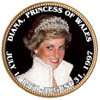
Princess Diana "Princess of Wales" Great Britain Penny
# CNS604 - Princess Diana "Princess of Wales" Great Britain Penny
$9.99
Although her marriage to Prince Charles elevated her social position, Lady Diana Spencer was hardly a commoner. Five lines of her family tree can be traced to England’s King Charles II – and the Stuart dynasty that ruled England from 1603 to 1714.
The Stuart dynasty began at the time of the death of England’s Queen Elizabeth I in 1603. King James of Scotland – son of Elizabeth’s cousin Mary, Queen of Scots – was next in line to the English throne. England and Scotland were united under one crown and ruled by the Roman Catholic Stuarts. King James I died in 1625 and was succeeded by his son Charles I.
Charles I reigned from 1625 to 1649. His conflicts with Parliament prompted the English Civil War, and led to him being convicted of treason and beheaded in 1649. The royal family went into exile until 1660 when his son, Charles II, returned to the English throne. Because Charles II left no legitimate heirs when he died in 1685, his brother became King James II. King James II’s attempts to bolster the monarchy and the Catholic faith led to Parliament’s rebellious Act of Settlement of 1701 and the demise of the Stuart dynasty.
The Act of Settlement of 1701 barred Catholics – and anyone married to one – from ruling England. Because the monarchy was largely Catholic, the first 51 people in line for the throne were ineligible. George I, a Hanover from Germany, Prince Charles of Wales’ direct ancestor, became the King of England.
Diana’s family has lived at the family estate, Althorp, since 1508. Her ancestor, Wilmington Spencer Compton, was made the first Earl of Spencer in 1730. Looking at her regal bearing, it’s not hard to understand why the public choose Diana as the “People’s Princess.”
Although her marriage to Prince Charles elevated her social position, Lady Diana Spencer was hardly a commoner. Five lines of her family tree can be traced to England’s King Charles II – and the Stuart dynasty that ruled England from 1603 to 1714.
The Stuart dynasty began at the time of the death of England’s Queen Elizabeth I in 1603. King James of Scotland – son of Elizabeth’s cousin Mary, Queen of Scots – was next in line to the English throne. England and Scotland were united under one crown and ruled by the Roman Catholic Stuarts. King James I died in 1625 and was succeeded by his son Charles I.
Charles I reigned from 1625 to 1649. His conflicts with Parliament prompted the English Civil War, and led to him being convicted of treason and beheaded in 1649. The royal family went into exile until 1660 when his son, Charles II, returned to the English throne. Because Charles II left no legitimate heirs when he died in 1685, his brother became King James II. King James II’s attempts to bolster the monarchy and the Catholic faith led to Parliament’s rebellious Act of Settlement of 1701 and the demise of the Stuart dynasty.
The Act of Settlement of 1701 barred Catholics – and anyone married to one – from ruling England. Because the monarchy was largely Catholic, the first 51 people in line for the throne were ineligible. George I, a Hanover from Germany, Prince Charles of Wales’ direct ancestor, became the King of England.
Diana’s family has lived at the family estate, Althorp, since 1508. Her ancestor, Wilmington Spencer Compton, was made the first Earl of Spencer in 1730. Looking at her regal bearing, it’s not hard to understand why the public choose Diana as the “People’s Princess.”



